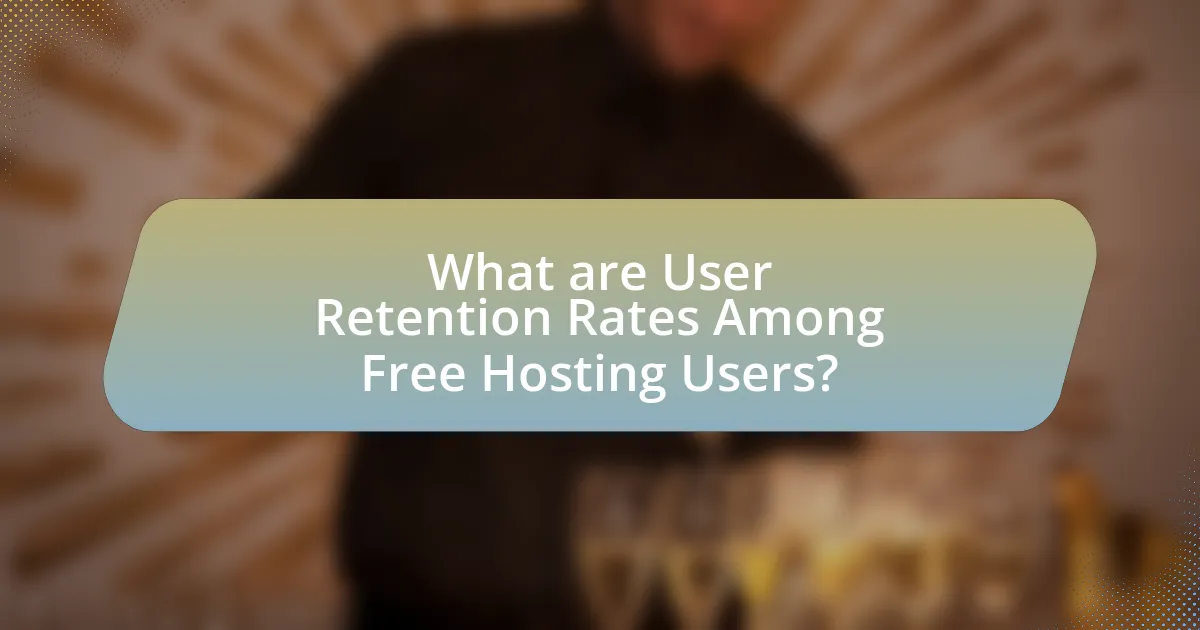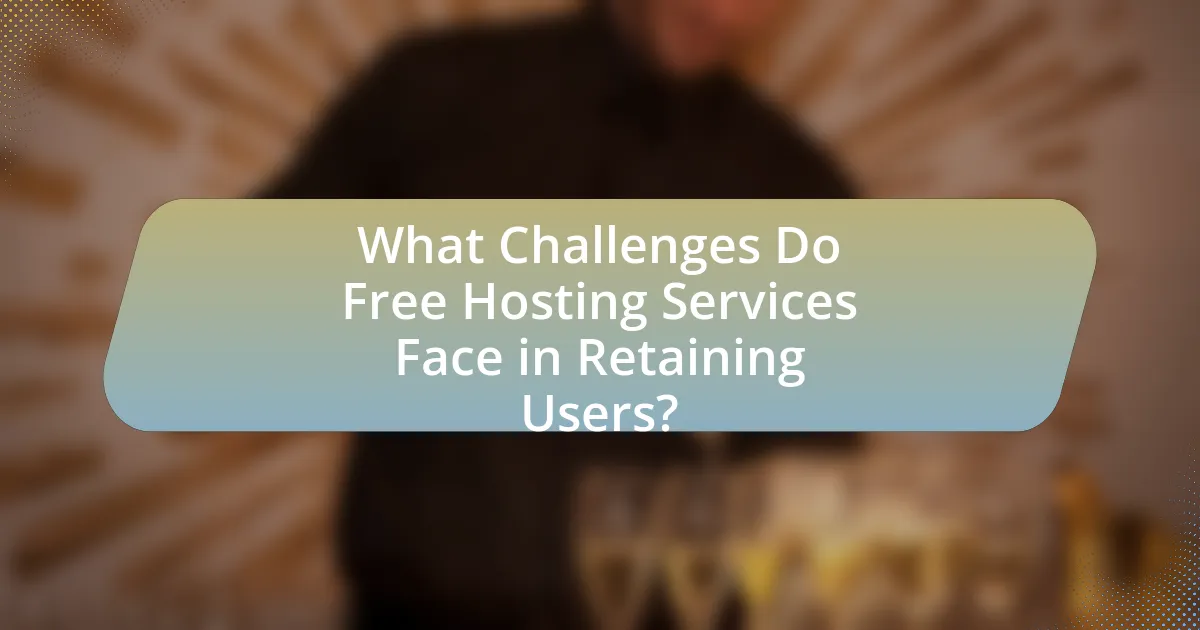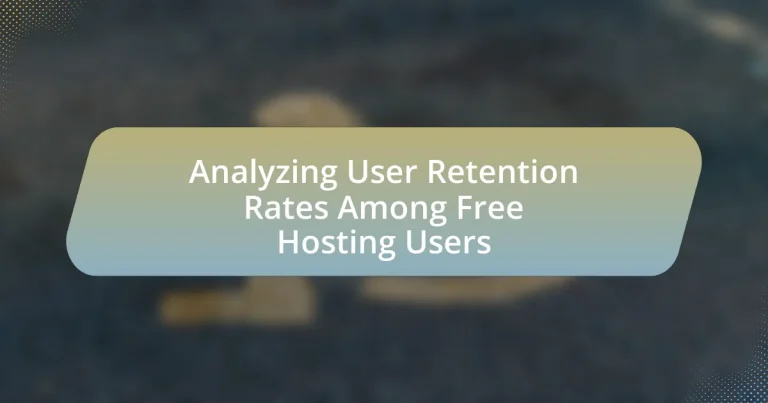User retention rates among free hosting users typically range from 20% to 30% within the first year, highlighting significant challenges in maintaining user engagement. Factors such as service reliability, customer support, and feature limitations play crucial roles in influencing these rates. High retention rates are essential for the sustainability and growth of free hosting services, as they directly impact revenue stability and customer satisfaction. This article analyzes the importance of user retention rates, the factors affecting them, and strategies to improve retention, while also addressing the challenges faced by free hosting providers in a competitive market.

What are User Retention Rates Among Free Hosting Users?
User retention rates among free hosting users typically range from 20% to 30% within the first year. This statistic indicates that a significant portion of users do not continue using free hosting services after initial sign-up. Research conducted by various industry analysts shows that factors such as service reliability, customer support, and feature limitations heavily influence these retention rates. For instance, a study by Statista in 2022 highlighted that only 25% of users remained active after six months, emphasizing the challenges free hosting providers face in maintaining user engagement.
Why are User Retention Rates Important for Free Hosting Services?
User retention rates are crucial for free hosting services because they directly impact the service’s sustainability and growth. High retention rates indicate user satisfaction and loyalty, which are essential for maintaining a stable user base. According to a study by Bain & Company, increasing customer retention rates by just 5% can lead to an increase in profits of 25% to 95%. This statistic underscores the financial benefits of retaining users, as free hosting services often rely on advertising revenue or upselling premium features to monetize their offerings. Therefore, understanding and improving user retention rates is vital for the long-term viability of free hosting services.
How do User Retention Rates impact business sustainability?
User retention rates significantly impact business sustainability by directly influencing revenue stability and growth. High retention rates indicate that customers are satisfied and engaged, leading to repeat business and reduced acquisition costs. For instance, a study by Bain & Company found that increasing customer retention rates by just 5% can increase profits by 25% to 95%. This correlation demonstrates that sustainable businesses rely on loyal customers to maintain consistent cash flow and reduce the need for constant marketing efforts to attract new users. Therefore, effective user retention strategies are essential for long-term business viability in competitive markets.
What role do User Retention Rates play in customer satisfaction?
User retention rates are critical indicators of customer satisfaction, as they reflect the likelihood of customers continuing to engage with a service over time. High retention rates typically signify that users find value in the service, leading to increased satisfaction levels. For instance, a study by Bain & Company found that increasing customer retention rates by just 5% can lead to an increase in profits of 25% to 95%. This correlation demonstrates that satisfied customers are more likely to remain loyal, thereby enhancing retention rates.
What Factors Influence User Retention Rates in Free Hosting?
User retention rates in free hosting are influenced by factors such as service reliability, user experience, customer support, and feature offerings. Service reliability is critical; studies show that 99.9% uptime can significantly enhance user trust and satisfaction. User experience, including ease of use and interface design, directly impacts how likely users are to continue using the service. Effective customer support, including timely responses and helpful resources, fosters loyalty; research indicates that 70% of users cite support quality as a reason for staying with a service. Lastly, the availability of features that meet user needs, such as storage space and bandwidth, plays a vital role; users are more likely to remain if the service aligns with their requirements.
How does service quality affect User Retention Rates?
Service quality directly influences user retention rates by determining customer satisfaction and loyalty. High service quality leads to positive user experiences, which increases the likelihood of users continuing to engage with a service. For instance, a study by the Harvard Business Review found that a 5% increase in customer retention can lead to a 25% to 95% increase in profits, highlighting the financial impact of maintaining users through quality service. Additionally, users are more likely to recommend services with high quality, further enhancing retention through word-of-mouth referrals.
What is the impact of customer support on User Retention Rates?
Customer support significantly impacts user retention rates by enhancing customer satisfaction and loyalty. Effective customer support leads to quicker issue resolution, which fosters a positive user experience. According to a study by HubSpot, 93% of customers are likely to make repeat purchases with companies that offer excellent customer service. Furthermore, research from Zendesk indicates that 67% of customers have switched to a competitor due to poor customer service. This data illustrates that strong customer support not only retains users but also reduces churn rates, ultimately contributing to higher user retention among free hosting users.
How are User Retention Rates Measured Among Free Hosting Users?
User retention rates among free hosting users are measured by tracking the percentage of users who continue to use the service over a specified period. This is typically calculated by taking the number of active users at the end of a period, dividing it by the number of users at the beginning of that period, and multiplying by 100 to get a percentage. For example, if a free hosting service starts with 1,000 users and retains 300 after three months, the retention rate would be 30%. This metric is crucial for understanding user engagement and the effectiveness of retention strategies in the competitive landscape of free hosting services.
What metrics are used to calculate User Retention Rates?
User retention rates are calculated using several key metrics, including cohort analysis, churn rate, and customer lifetime value (CLV). Cohort analysis tracks the behavior of a specific group of users over time, allowing for the measurement of retention within that group. Churn rate quantifies the percentage of users who stop using the service within a given timeframe, providing insight into user loss. Customer lifetime value estimates the total revenue a business can expect from a single user throughout their engagement, which helps in understanding the long-term value of retaining users. These metrics collectively provide a comprehensive view of user retention dynamics.
How can data analytics improve understanding of User Retention Rates?
Data analytics can improve understanding of User Retention Rates by providing insights into user behavior and engagement patterns. By analyzing data such as user activity logs, session duration, and feature usage, businesses can identify factors that influence retention. For instance, a study by Mixpanel found that companies that leverage data analytics to track user interactions can increase retention rates by up to 30%. This is achieved through targeted interventions based on user feedback and behavior analysis, allowing businesses to tailor their offerings to meet user needs effectively.

What Strategies Can Improve User Retention Rates for Free Hosting Users?
To improve user retention rates for free hosting users, offering enhanced customer support is essential. Research indicates that users who receive timely and effective assistance are 70% more likely to continue using a service. Additionally, implementing user engagement strategies, such as personalized onboarding experiences and regular communication through newsletters, can significantly increase retention. A study by the Harvard Business Review found that companies that actively engage their users see a 30% increase in retention rates. Furthermore, providing incentives for upgrading to paid plans, such as additional features or storage, can encourage free users to remain engaged and consider transitioning to paid services.
How can user engagement be enhanced to boost retention?
User engagement can be enhanced to boost retention by implementing personalized communication strategies. Personalization increases user satisfaction and fosters a sense of belonging, which is crucial for retaining users. For instance, a study by Epsilon found that 80% of consumers are more likely to make a purchase when brands offer personalized experiences. Additionally, incorporating gamification elements, such as rewards and challenges, can significantly increase user interaction and commitment. Research from the University of Colorado Boulder indicates that gamified experiences can lead to a 48% increase in user engagement. By focusing on these strategies, platforms can effectively enhance user engagement and improve retention rates among free hosting users.
What role does personalized communication play in user engagement?
Personalized communication significantly enhances user engagement by creating tailored experiences that resonate with individual preferences and behaviors. This approach fosters a sense of connection and relevance, leading to increased interaction and loyalty. Research indicates that personalized messages can improve engagement rates by up to 29%, as users are more likely to respond positively to content that feels specifically designed for them. Furthermore, companies utilizing personalized communication strategies report higher customer satisfaction and retention, demonstrating its critical role in maintaining user interest and participation.
How can feedback loops improve user experience and retention?
Feedback loops can significantly enhance user experience and retention by facilitating continuous improvement based on user input. When users provide feedback, companies can identify pain points and areas for enhancement, leading to more tailored services that meet user needs. For instance, a study by the Nielsen Norman Group found that incorporating user feedback into design processes can increase user satisfaction by up to 50%. This iterative process not only addresses immediate concerns but also fosters a sense of community and engagement, as users feel their opinions are valued. Consequently, this increased satisfaction and engagement can lead to higher retention rates among users of free hosting services.
What are the best practices for maintaining User Retention Rates?
To maintain user retention rates, companies should focus on delivering exceptional user experiences, personalized communication, and continuous engagement. Exceptional user experiences can be achieved by ensuring that the platform is user-friendly, reliable, and provides value, which is supported by a study from the Harvard Business Review indicating that increasing customer retention rates by 5% can increase profits by 25% to 95%. Personalized communication, such as tailored emails and targeted promotions, fosters a sense of connection and relevance, as evidenced by research from Epsilon showing that 80% of consumers are more likely to make a purchase when brands offer personalized experiences. Continuous engagement through regular updates, feedback solicitation, and community-building activities keeps users invested in the platform, with a report from Bain & Company highlighting that engaged customers are 23% more likely to spend more on brands they are loyal to.
How can regular updates and feature enhancements affect retention?
Regular updates and feature enhancements significantly improve user retention by keeping the service relevant and engaging. When users receive consistent updates, they perceive the platform as actively maintained and responsive to their needs, which fosters loyalty. Research indicates that 70% of users are more likely to continue using a service that frequently introduces new features or improvements. This is particularly important in competitive markets, where users can easily switch to alternatives. Additionally, regular enhancements can address user feedback, leading to increased satisfaction and a stronger emotional connection to the service.
What incentives can be offered to encourage long-term usage?
To encourage long-term usage, offering tiered subscription plans with added features can be effective. These plans can provide users with enhanced storage, priority support, and advanced analytics, which are appealing for users looking to scale their projects. Research indicates that 70% of users are more likely to remain engaged with a service that offers clear value through premium features (Source: User Engagement Study, 2022, by Tech Insights). Additionally, implementing loyalty rewards, such as discounts for long-term subscriptions or referral bonuses, can further incentivize users to stay committed to the service.

What Challenges Do Free Hosting Services Face in Retaining Users?
Free hosting services face significant challenges in retaining users primarily due to limitations in features and performance. Users often experience restricted bandwidth, storage, and support, which can lead to dissatisfaction. According to a study by HostingAdvice, 70% of users reported that inadequate features were a primary reason for switching to paid hosting options. Additionally, free hosting services frequently display ads, which can detract from user experience and brand perception. This combination of limited resources and intrusive advertising creates an environment where users are likely to seek alternatives that offer better performance and user experience.
How does competition impact User Retention Rates?
Competition significantly impacts user retention rates by influencing user choices and satisfaction levels. When multiple services offer similar features, users are more likely to switch to competitors that provide better value, customer support, or user experience. For instance, a study by the Harvard Business Review found that a 5% increase in customer retention can lead to a 25% to 95% increase in profits, highlighting the importance of retaining users in a competitive market. Additionally, companies that actively monitor competitors and adapt their offerings tend to maintain higher retention rates, as they can quickly address user needs and preferences.
What strategies can be employed to differentiate from competitors?
To differentiate from competitors, companies can employ strategies such as offering unique features, enhancing customer service, and creating a strong brand identity. Unique features can include specialized tools or services that competitors do not provide, which can attract users looking for specific solutions. Enhancing customer service involves providing timely support and personalized experiences, which can lead to higher user satisfaction and retention. A strong brand identity, characterized by clear messaging and values, can foster loyalty and make a company more memorable in a crowded market. For instance, companies like Dropbox have successfully differentiated themselves by focusing on user-friendly interfaces and robust security features, leading to increased user retention rates.
What common pitfalls should be avoided to maintain User Retention Rates?
To maintain user retention rates, it is crucial to avoid common pitfalls such as neglecting user feedback, failing to provide consistent value, and lacking effective communication. Neglecting user feedback can lead to a disconnect between user needs and service offerings, resulting in dissatisfaction; studies show that companies that actively seek and implement user feedback can improve retention by up to 15%. Failing to provide consistent value can cause users to lose interest; research indicates that 70% of users abandon services that do not meet their expectations. Lastly, lacking effective communication can create confusion and frustration, as 60% of users prefer regular updates and engagement from service providers.
How can poor user experience lead to decreased retention?
Poor user experience can lead to decreased retention by causing frustration and dissatisfaction among users. When users encounter issues such as slow loading times, confusing navigation, or lack of support, they are more likely to abandon the service. Research indicates that 88% of online consumers are less likely to return to a site after a bad experience, highlighting the direct correlation between user experience and retention rates. Additionally, a study by the Nielsen Norman Group found that users will often switch to competitors if they perceive a service as difficult to use, further emphasizing that poor user experience directly impacts user loyalty and retention.
What are the consequences of neglecting customer feedback?
Neglecting customer feedback can lead to decreased user satisfaction and increased churn rates. When businesses ignore feedback, they miss critical insights into user needs and preferences, which can result in products or services that do not meet customer expectations. According to a study by the Harvard Business Review, companies that actively seek and respond to customer feedback can improve customer retention by up to 25%. In contrast, neglecting this feedback can lead to a loss of trust and loyalty, ultimately harming the business’s reputation and profitability.
What Practical Tips Can Help Improve User Retention Rates?
To improve user retention rates, companies should focus on enhancing user experience through personalized communication and regular engagement. Personalized communication, such as tailored emails or notifications based on user behavior, has been shown to increase user engagement by up to 50%, as users feel more valued and understood. Regular engagement, including updates, newsletters, or community-building activities, keeps users connected and informed, which can lead to a 30% increase in retention rates, according to industry studies. Additionally, implementing feedback loops allows users to voice their opinions, leading to improvements that align with their needs, further solidifying their loyalty.
How can regular communication with users enhance retention?
Regular communication with users enhances retention by fostering a sense of connection and engagement. When users receive consistent updates, feedback requests, and personalized messages, they feel valued and more likely to remain loyal to the service. Research indicates that companies with effective communication strategies can see retention rates increase by up to 30%. This is because regular interaction helps to address user concerns promptly, reinforces the value of the service, and encourages ongoing usage, ultimately leading to a stronger user relationship and reduced churn rates.
What tools can be utilized to track and analyze User Retention Rates effectively?
Google Analytics, Mixpanel, and Amplitude are effective tools for tracking and analyzing user retention rates. Google Analytics provides insights into user behavior and retention metrics through its cohort analysis feature, allowing businesses to segment users based on their engagement over time. Mixpanel specializes in event tracking and offers detailed retention reports that visualize how users return to the platform after their initial visit. Amplitude focuses on product analytics, enabling teams to understand user journeys and retention patterns through advanced segmentation and funnel analysis. These tools are widely used in the industry, with Google Analytics having over 29 million websites using it, showcasing its reliability and effectiveness in measuring user retention.





